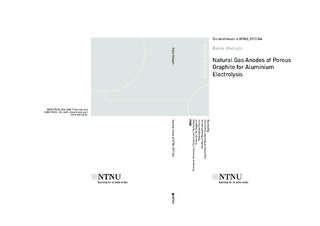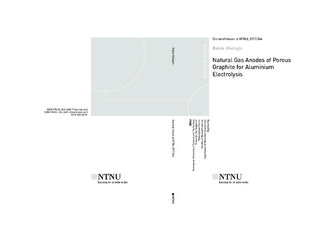| dc.contributor.advisor | Haarberg, Geir Martin | |
| dc.contributor.advisor | Mokkelbost, Tommy | |
| dc.contributor.advisor | Kjos, Ole Sigmund | |
| dc.contributor.author | Khalaghi, Babak | |
| dc.date.accessioned | 2017-09-29T08:12:38Z | |
| dc.date.available | 2017-09-29T08:12:38Z | |
| dc.date.issued | 2017 | |
| dc.identifier.isbn | 978-82-326-2601-4 | |
| dc.identifier.issn | 1503-8181 | |
| dc.identifier.uri | http://hdl.handle.net/11250/2457409 | |
| dc.description.abstract | Aluminium is the second metal produced in the world in terms of quantity. It is produced in a multistage process. First, aluminium ore is converted to pure aluminium oxide. The second stage is an electrolysis process. In this stage, aluminium oxide is dissolved in a mixture of molten salts. Then, electrical current is passed through this mixture which leads to production of liquid aluminium. The electrical current is introduced to the cell through carbon electrodes. This is the so-called Hall-Héroult process and is the only industrial process for aluminium production.
One of the main downsides of the Hall-Héroult process is the large amounts of CO2 which are emitted from the electrolysis cell as the by-product of this process. CO2 which is a greenhouse gas, is generated in this process due to consumption of carbon anodes.
The main objective of this study was to develop an alternative process to reduce the undesired CO2 emissions during electrolysis. In this new process, the common baked carbon anodes were replaced by porous graphite anodes. Then, graphite anodes were supplied by methane (natural gas) during the electrolysis process. Consequently, methane participated in the reactions at the anode. Hence, consumption of the anode and in return, CO2 emissions were significantly decreased.
Controlled laboratory experiments were carried out. Electrochemical measurements and other techniques were utilised to reveal the ongoing phenomena. Different graphite grades were tested as anode material. Besides, experimental conditions were also varied to achieve the best performance. Consequently, the main key parameters of the process were revealed. The consumption of the anode was reduced up to 35 wt. %. The best anode material properties were also identified.
Further studies in the future can lead to industrialisation of this new process. This would be a big step towards making aluminium production more environmentally friendly. | nb_NO |
| dc.language.iso | eng | nb_NO |
| dc.publisher | NTNU | nb_NO |
| dc.relation.ispartofseries | Doctoral theses at NTNU;2017:266 | |
| dc.relation.haspart | Paper 1: Khalaghi, Babak; Gudbrandsen, Henrik; Kjos, Ole Sigmund; Osen, Karen Sende; Mokkelbost, Tommy; Haarberg, Geir Martin. Porous Carbon Anodes for the Supply of Methane during Electrowinning of Aluminium. I: Light Metals 2016 s.915-920
http://dx.doi.org/10.1002/9781119274780.ch154 | nb_NO |
| dc.relation.haspart | Paper 2: Haarberg, Geir Martin; Khalaghi, Babak; Mokkelbost, Tommy. Natural Gas Anodes for Aluminium Electrolysis in Molten Fluorides. Faraday discussions (Online) 2016 ;Volum 190. s. 71-84
http://dx.doi.org/10.1039/C5FD00239G | nb_NO |
| dc.relation.haspart | Paper 3: Khalaghi, Babak; Gudbrandsen, Henrik; Kjos, Ole Sigmund; Osen, Karen Sende; Paulsen, Ove; Mokkelbost, Tommy; Haarberg, Geir Martin. Gas Anodes Made of Porous Graphite for Aluminium Electrowinning. Light Metals 2017 s. 1333-1339
https://doi.org/10.1007/978-3-319-51541-0_159 | nb_NO |
| dc.relation.haspart | Paper 4: Gas anode made of porous graphite for aluminium electrowinning | nb_NO |
| dc.relation.haspart | Paper 5: Cyclic voltammetry and double layer capacitance of porous graphite electrodes in cryolite-alumina melts | nb_NO |
| dc.title | Natural Gas Anodes of Porous Graphite for Aluminium Electrolysis | nb_NO |
| dc.type | Doctoral thesis | nb_NO |

